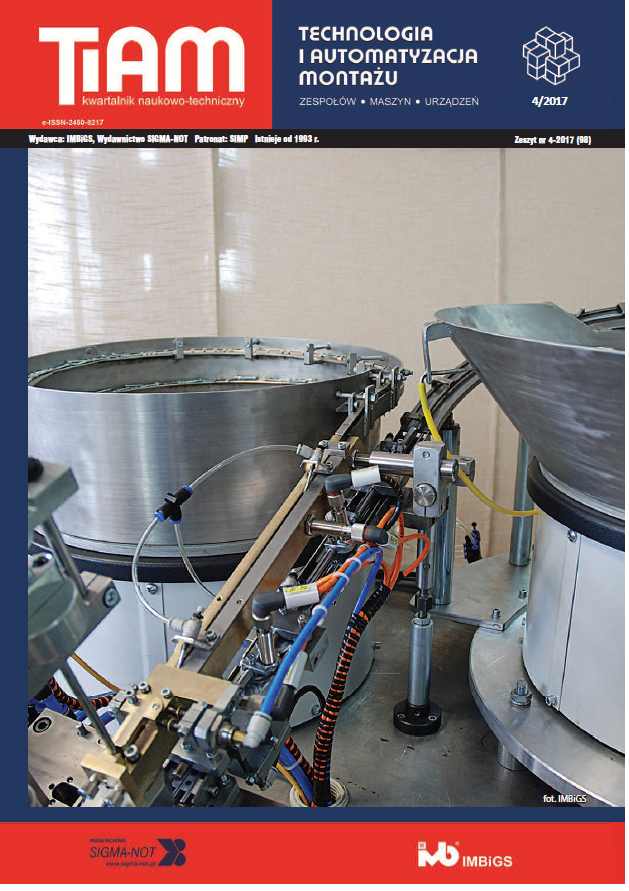Abstract
Welding process it is one of the most commonly used technology for the joining materials. During the welding process often occurs in thin plate the welding distortion. The distortion causes problems not only in the assembling process but also in the final product quality. Pneumatic shot peening is one of the burnishing methods. It is widely used to improve the fatigue strength of the material. In this article, the scheme and working principle of head for the shot peening process of plate and butt-welded joints was presented.
This is an Open Access article distributed under the terms of the Creative Commons Attribution License CC BY 4.0 (https://creativecommons.org/licenses/by/4.0/)
References
Banaś G. 1987. „Zwiększanie wytrzymałości zmęczeniowej złączy spawanych metodami nagniatania. Nowe technologie nagniatania i ich zastosowanie w przemyśle elektromaszynowym”. Rzeszów: Zakład Małej Poligrafii Politechniki Rzeszowskiej: 125–137.
Bucior M. et.al. 2015. “The effect of technological parameters on intensity of shot peening process of 51CrV4 steel”. Conference Proceedings, 8-th International Symposium on Mechanics of Materials and Structures and Fracture and Fragmentation Technologies in Science and Engineering Conference, Augustów: 34–35.
Fedoryszyn A. i in. 2010. „Efekty obróbki powierzchniowej strumieniem śrutu”. XII Konferencja Odlewnicza Technical: 19–31.
Grinspan A. S., R. Gnanamoorthy. 2007. “Surface modification and fatigue behavior of high-pressure oil jet peened medium carbon steel AISI 1040, Transaction of the ASME”. Journal of Manufacturing Science and Engineering, Vol.129: 601–606.
Łunarski J. 1987. „Możliwości technologiczne procesu pneumokulowania”. Zeszyty Naukowe Politechniki Rzeszowskiej (35): 41–51.
Łunarski J. 1987. „Przegląd metod nagniatania i ich wpływ na właściwości użytkowe elementów maszyn”. Zbiór referatów pod red. J. Łunarskiego „Nowe technologie nagniatania i ich zastosowanie w przemyśle elektromaszynowym”. Zakład Małej Poligrafii i Politechniki Rzeszowskiej, 1987.
Nakonieczny A., G. Mońka. 2004. „Wpływ kulowania na wytrzymałość zmęczeniową stali sprężynowej po oddziaływaniu korozji”. Inżynieria Powierzchni (3): 14–19.
Nakonieczny A. 2002. „Dynamiczna powierzchniowa obróbka plastyczna, kulowanie”. Warszawa: Instytut Mechaniki Precyzyjnej.
Nasiłowska B. 2015. „Wpływ kulowania na strukturę, mikrotwardość i naprężenia własne stali austenitycznej 1.4539”. Biuletyn WAT, Vol. 64 (2): 103–110.
Nur Azida Che Lah. 2010. “The effect of controlled shot peening on fusion welded joints”. Materials and Design (31): 312–324.
Nyklewicz J. 1987. „Ocena intensywności pneumokulowania według parametrów nierówności powierzchni umocnionej”. Zeszyty Naukowe Politechniki Rzeszowskiej (35): 117–123.
Przybylski W. 1987. „Technologia obróbki nagniataniem”. Warszawa: WNT.
Śledź M., F. Stachowicz, W. Zielecki. 2015. “The effect of shot peening on the fatigue strength of steel sheets”. Kovove Materialy – Metallic Materials. Vol. 53, (2): 91–95.
Śledź M., W. Zielecki, Ł. Bąk. 2014. „Wpływ pneumokulkowania na wytrzymałość zmęczeniową wybranych blach stalowych”. Monografia – Wybrane zagadnienia i problemy z zakresu budowy maszyn. Cz. 1. Rzeszów: 69–83.


